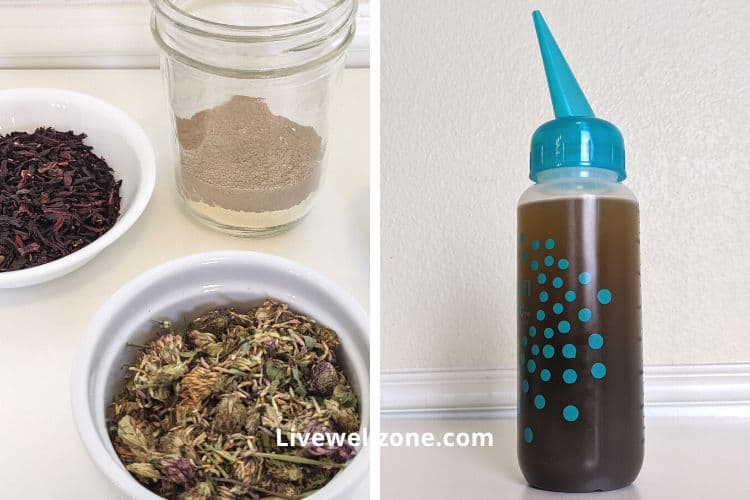
One of the best – and most fun – ways to take your hair care routine to the next level is to learn the art and science of infusing herbs oil.
By making your own hair care oil, you get to choose ingredients that truly match your specific hair needs. Plus, you have control over how much of each herb you use (unlike many store bought growth oils that come with “filler” ingredients that don’t contribute to luscious locks).
So, if you’d like to learn more, then keep reading because this article will show you:
- the best oils and herbs to use for a hair growth oil.
- two ways to make an herb-infused hair oil.
- a recipe that you can use at home to make your first batch.
Let’s get to it!
Note: this post contains affiliate links and I earn a commission (at no additional cost to you) if you use them to make a purchase.
BEST HERBS TO INFUSE IN OIL FOR HAIR GROWTH: HORSETAIL, FENUGREEK, NETTLE, ROSEMARY & MORE
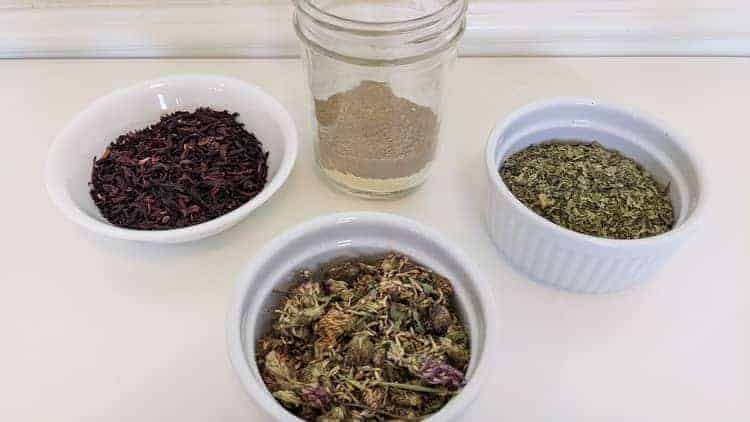
In order to choose the best herbs for a hair growth oil, it helps to understand some of the mechanics of what contributes to hair loss. In this case we’re going to look specifically at 5-alpha reductase, DHT and keratinocytes (source).
5-alpha reductase
- This is an enzyme that converts testosterone to DHT (5-alpha dihydrotestosterone aka DHT).
- DHT is more potent than testosterone and it is said to be one of the underlying causes of hair loss in men and women.
- Using herbs that inhibit 5-alpha reductase can help prevent the cascade of events that lead to hair loss.
| Herbs that inhibit 5-alpha reductase and DHT |
|---|
| Stinging nettle |
| Red clover |
| Amla |
| Saw palmetto |
| Panax ginseng |
| Tea (green and black) |
| Fo-Ti (aka He Shou Wu) |
| Kudzu |
| Ginger |
Keratinocytes
- Hair growth starts with the production of keratinocytes, which are cells that make keratin (the main protein in hair strands).
- The production of keratinocytes occurs within the dermis (the inner layer of the skin/scalp).
- For some people keratinocyte apoptosis (or death) seems to be an underlying factor that contributes to hair loss.
- Using herbs that protect keratinocytes and encourage keratinocyte production might be helpful.
| Herbs that support keratinocytes |
|---|
| Bhringaraj |
| Angelica |
In addition to the above, there are many other herbs that are frequently used for hair growth. Some of them support hair growth by:
- increasing blood flow to the scalp (which stimulates follicles).
- reducing scalp inflammation.
- treating dandruff.
- having a conditioning effect on the hair that’s already on your head (and this preventing breakage).
Here’s a quick look at some of these other herbs that are great for hair.
| Herb | Benefits |
|---|---|
| Fenugreek | popular Ayurvedic herb that has traditionally been used to thicken and condition hair. Antibacterial and antifungal. Rich in nutrients like protein, iron and vitamins (A, K and C). Reduces scalp inflammation and shedding (source). |
| Aloe vera | traditionally used as a hair growth aid in parts of Asia, Africa and the Mediterranean (source). Rich in vitamins that support healthy hair; helps with dandruff, dryness. Potent conditioner. |
| Rosemary | contains antioxidants and volatile compounds that stimulate hair growth. Has been shown to be as effective as minoxidil without the side effects. Often used as an infused oil, tea rinse and essential oil. Soothes inflamed scalp. |
| Hibiscus flowers | Ayurvedic herb that is used to condition the hair (thanks to its mucilage content). some research suggests that the leaves may be more potent than the flowers (source). |
| Horsetail | mineral-rich herb that is used to promote hair growth and reverse hair loss; very rich in silica, a mineral that helps with hair growth; some research shows that it also inhibits 5-alpha reductase (source). |
| Thyme | contains antioxidants and volatile compounds that support healthy hair. Used as an infused oil, tea rinse and essential oil. Soothes inflamed scalp. |
BEST OILS TO USE WHEN INFUSING HERBS FOR HAIR
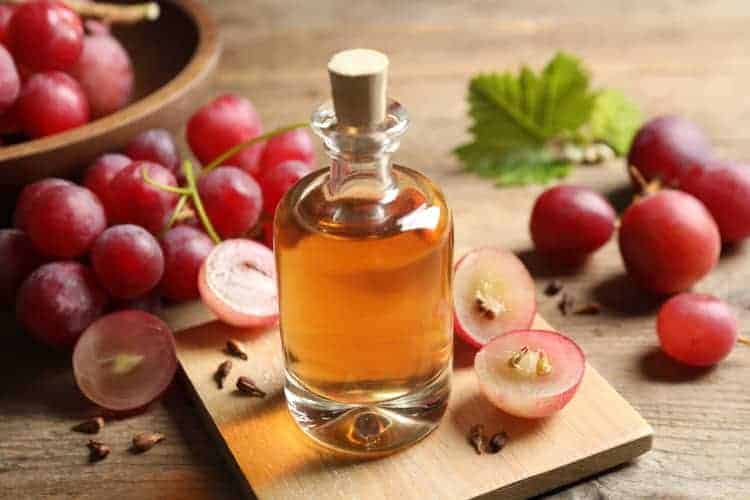
When making an herb-infused oil for your hair, it’s important to choose a base oil with a long shelf life (1 year or more). The longer the shelf life, the lower the chances of the oil going rancid before you’ve had a chance of using up the entire batch that you prepared.
Also, keep in mind that storing your oils in a cool, dry place (such as a refrigerator) can help them to stay fresh.
Furthermore, some oils do change appearance based on temperature. For example, unrefined coconut oil melts above 76°F and jojoba oil becomes cloudy at cooler temperatures. But have no worries; these changes are purely visual and doesn’t mean the oil has gone bad.
In addition to shelf life, choosing carrier oils that are in either linoleic and linolenic acid may also be very beneficial. This is because some studies indicate that topical application of both fatty acids stimulates hair growth. What’s even more interesting is that, these fatty acid seem to inhibit 5-alpha reductase, thus blocking DHT (1, 2, 3).
Some of the carrier oils that are good sources of both linoleic and linolenic acid include:
- pumpkin seed oil.
- sunflower oil.
- flaxseed oil.
Now, here a list of carrier oils that you can use on the hair and their shelf life (when stored under the right conditions, per manufacturer’s instructions).
| Carrier oil | Shelf life |
|---|---|
| Almond oil (sweet) | 1 year |
| Argan oil | 1-2 years |
| Avocado oil | 1 year |
| Camellia seed oil | 1-1.5 years |
| Coconut (virgin and fractionated) | 2-3 years |
| Flaxseed oil | 2 years |
| Grapeseed oil | 1 year |
| Jojoba oil | almost indefinite if stored properly |
| Olive oil | 2 years |
| Pumpkin seed oil | 1 year |
| Sunflower | 1 year |
| Sesame | 1 year |
HOW TO MAKE AN HERB-INFUSED OIL FOR HAIR GROWTH: TRADITIONAL, SLOW METHOD
1. Fill a clean, sterilized jar 1/2 way with dried herbs or 1/4 of the way with herbal powder. If you’re using dried herbs, it helps to grind them down with a mortar and pestle (if you have one). This exposes more surface area of the herb, making for a more potent oil. Once ground, put the herbs back into the jar.
2. Cover the herbs with a carrier oil of your choice, filling the jar almost to the top (allow about 1 inch of space at top).
3. Seal the jar with the lid.
4. Roll the jar in between the palms of your hand and then shake a few times.
5. At this point you have one of two options:
- OPTION 1: Place the jar in a dark cupboard or cabinet for 4 – 6 weeks. Shake the jar every 2 to 3 days. After 4 – 6 weeks strain the herbs out of the oil. If you used whole herbs, a strainer or cheesecloth with do. If you used powders, then you’ll need a muslin bag to strain them out. Store the infused oil in a bottle with a spout (for easier application on the scalp).
- OPTION 2: Cover the jar with something opaque (paper bag or cloth). Place the jar in the sun or on a window sill that gets lots of sun for 2 weeks. Shake the jar every 2 to 3 days. Then strain out the herbs. Store the infused oil in a bottle with a spout (makes it easier to apply directly onto the scalp).
THE FASTEST WAY TO INFUSE HERBS IN OIL FOR HAIR
Using a crock pot that is set to WARM (not LOW) is the best way to get a good quality infused oil really quickly. But do keep in mind that for this to work, the temperature should not go above 140°F.
I’ve noticed that if I leave my crockpot uncovered, the WARM temperature stays at about 100°F and if I cover it then it gets to about 135°F. So, make sure to double check your crockpot’s WARM temperature to see where it sits.
NOTE: some people also use a double boiler on a stovetop to infuse oils. However, I stay away from that method because although it’s fast, the quality of the oil isn’t as good as the crockpot method.
1. Fill a jar with herbs as described in the “Traditional Method” above.
2. Place a thick washcloth or kitchen towel at the bottom of the crockpot.
3. Fill the crockpot about 1/3 full with water.
4. Turn on the crockpot and set to WARM.
5. Place the jar (with the lid on) into the crockpot. Make sure to place it on top of the washcloth or kitchen towel. This helps protect the jar from cracking.
6. Allow the jar to sit in the crockpot for 8 hours (or more). If the water level starts to go down, add more.
7. After at least 8 hours, turn off the crockpot. Leave the jar in the crockpot until the oil has cooled (this will take a few more hours).
8. Strain the herbs through cheesecloth (this won’t get every last bit of herb/powder) or better yet, a muslin bag or coffee filter.
HOMEMADE HERBAL OIL RECIPE FOR HAIR GROWTH
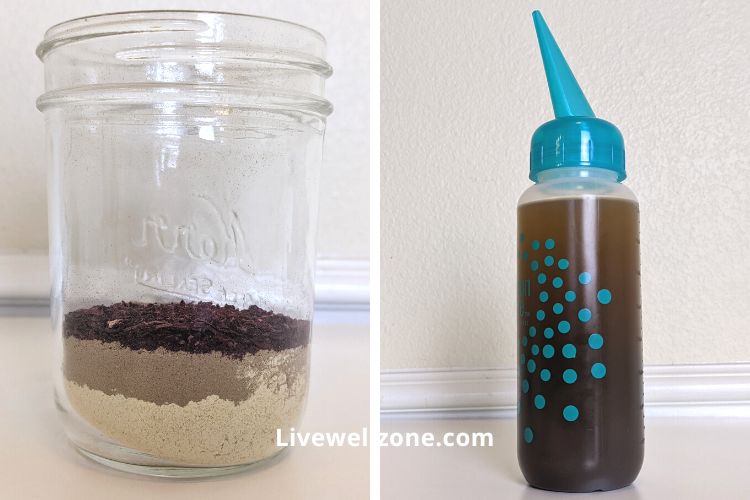
INGREDIENTS
1/4 cup fenugreek powder – GET IT HERE
3 Tbsp aloe vera powder – GET IT HERE
2 Tbsp hibiscus flowers (GET IT HERE) or 1 Tbsp hibiscus powder (GET IT HERE)
8-ounce glass mason jar – GET IT HERE
Almond oil (or another carrier oil of your choice) – GET IT HERE
Optional: 216 drops (approx. 2 1/3 teaspoons) of essential oils – see the instructions for details
INSTRUCTIONS
1. Put the aloe vera and fenugreek powders into a glass jar.
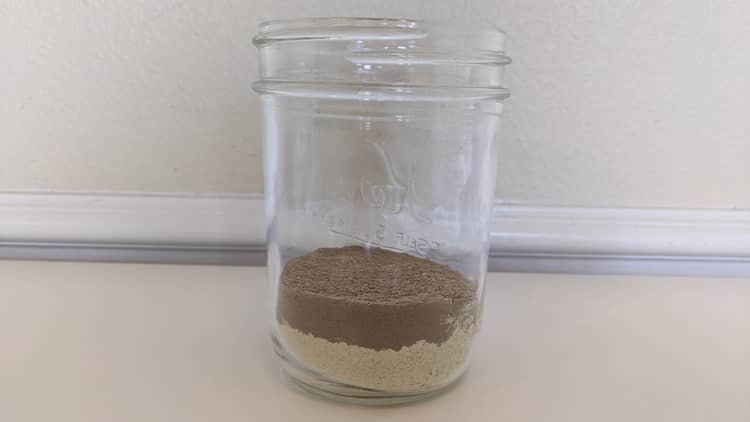
2. Measure out the hibiscus flowers and grind them in a mortar and pestle (doesn’t have to be a fine powder, just break them up). If you don’t have any way of grinding them, skip this step.

3. Add the hibiscus into the jar.
4. Fill the jar with almond oil, allowing about 1 inch of space at the top. Stir the ingredients well.
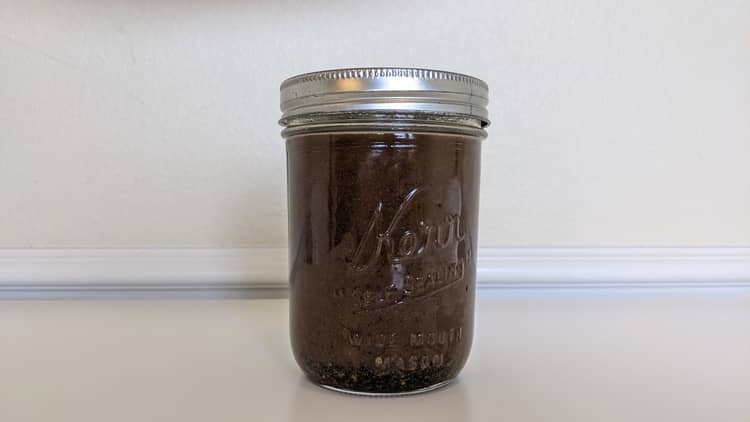
5. Seal the jar with a lid.
6. Place a folded kitchen towel at the bottom of a crockpot.
7. Fill the crockpot 1/3 full with water. 8. Place the jar in the crockpot.
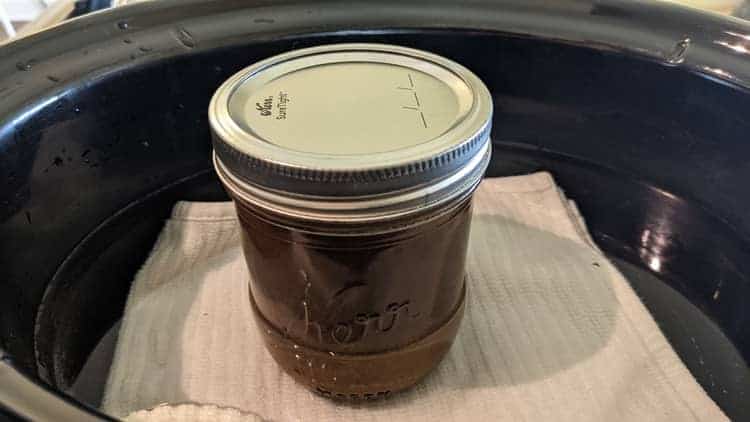
9. Set the crockpot to WARM.
10. Allow to simmer for 8 hours. I like to keep the lid on and then I only remove it after several hours when the temperature start to get to above 130°F.
11. After at least 8 hours, turn off the crockpot. Let the jar sit in the water until the oil has completely cooled down. During this time the herbs will settle at the bottom of the jar.

12. Pour the oil through cheesecloth to strain the herbs. This will get some, but not all of it. If you want to remove every last bit of herb, use a muslin bag.
13. Store your oil in an applicator bottle. NOTE: I used cheesecloth to strain my herbs so there is still some powder in my oil (hence the darker color).
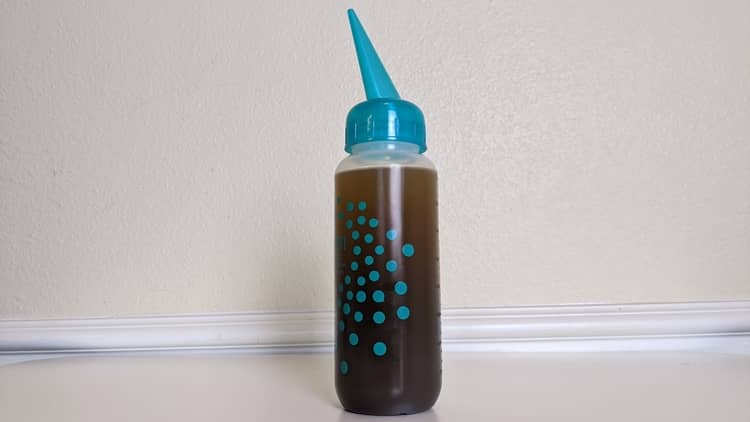
15. Optional: you can add essential oils to your oil. Some of the best to use include peppermint, rosemary, thyme and even, coffee essential oil. For more details on their specific benefits and how to use them, check out this guide on how to mix essentials for hair growth.
CONCLUSION
Making your own hair growth oil can be as easy as using one herb or a combination of herbs. I hope that this article has helped you get a better understanding of how to make your own unique blends. Have fun with it!
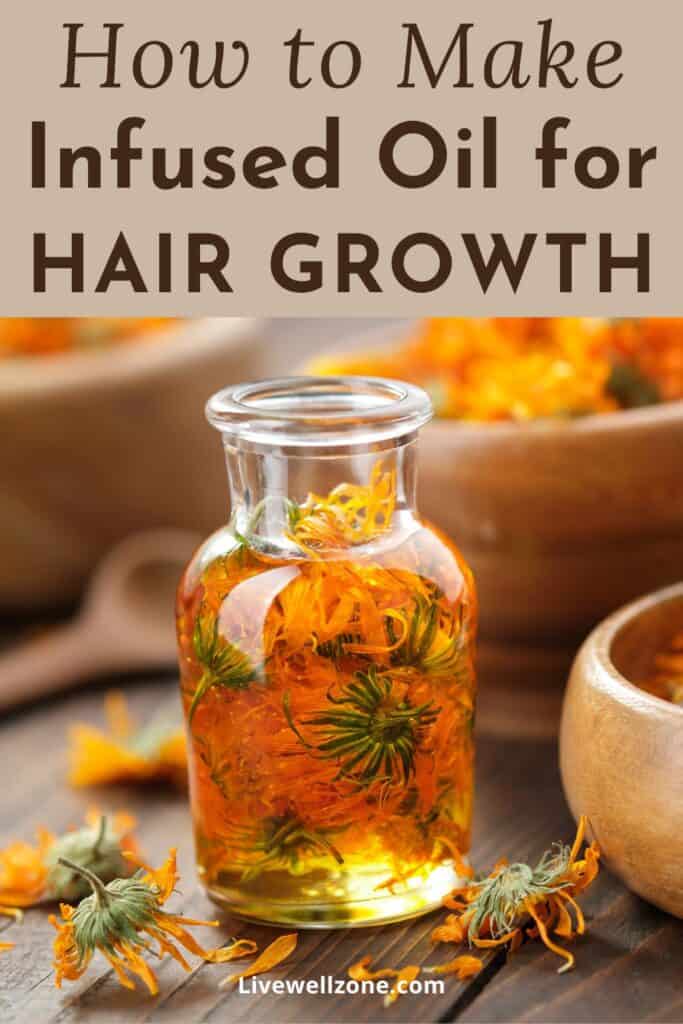
You Might Also Enjoy:
Lightweight Oils for 4C Hair: Reduce Breakage and Promote Growth
DIY Lavender Essential Oil Recipes for Hair
Best Carrier Oils for Hair Loss and Regrowth: A Complete Guide
Tea Rinses for Hair Growth: Beginner’s Guide with Top Herbs and Recipes
What To Mix With Shea Butter for Skin and Hair: Tips and Recipes
Rose Oil vs Rosehip Oil for Skin And Hair: Benefits | Which is Better | How To Use

